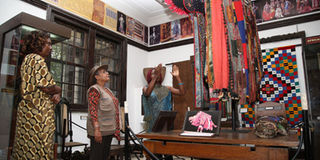Five great pioneering artists of East Africa exhibit at Nairobi Gallery

First Lady Margaret Kenyatta tours the Nairobi Gallery which is home to the Murumbi African Heritage Collections. At Nairobi Gallery currently, the art of five East African artists who the exhibition’s curator calls ‘pioneers’ are on display from December 17 up to April 2017. PHOTO | FILE | PSCU
What you need to know:
- Ironically, three out of the four Ugandan artists in the East African pioneers show didn’t attend Makerere officially. Only John Odoch Ameny did and Jak Katarikawe was technically tutored there by a Tanzanian art lecturer, Sam Ntiru.
- Onyango has two classic paintings in this show, one of old Mombasa, the other portraying a moment in his life with Drosey, an English woman who sadly died before the two could be wed
- One of Kenya’s earliest art collectors, Murumbi tried to interest his fellow government officials in the arts, especially to help him establish a Kenyan National Art Gallery. But then as now, local politicians were not interested in the arts.
Kenyans have been giving some thought to our heroes these days. But how often do we think of heroes who are cultural freedom fighters, artists who pave the way for our visual artists, our sculptors and painters.
At Nairobi Gallery currently, the art of five East African artists who the exhibition’s curator calls ‘pioneers’ are on display from December 17 up to April 2017.
Several of the five are Ugandans, which is understandable given that they had their own Fine Arts School at Makerere University back in the 1930’s.
Ironically, three out of the four Ugandan artists in the East African pioneers show didn’t attend Makerere officially. Only John Odoch Ameny did and Jak Katarikawe was technically tutored there by a Tanzanian art lecturer, Sam Ntiru.
Otherwise, Jak didn’t attend much formal schooling. But he had talent which was spotted by another university man and set Jak on the path to a creative arts career. Two of his signed prints are available at the gallery
Francis Nnaggenda got his fine arts training elsewhere before he became chair of Makerere’s Fine Art Department. Before that, he spent several years in Kenya and his biggest fan was the former Kenyan vice-president, Joseph Murumbi.
CLASSIC PAINTINGS
One of Kenya’s earliest art collectors, Murumbi tried to interest his fellow government officials in the arts, especially to help him establish a Kenyan National Art Gallery. But then as now, local politicians were not interested in the arts. Murumbi eventually left politics altogether and devoted his life to promoting pan-African arts.
Most of Nairobi Gallery (as well as the ground floor of the National Archives) is dedicated to Murumbi’s collections. But Richard Onyango, (the one Kenyan artist in the show) and Sanaa Gateja were too young to be known or collected by the former VP. Yet both are considered ‘pioneers’ by Murumbi’s former business partner, Alan Donovan.
Onyango has two classic paintings in this show, one of old Mombasa, the other portraying a moment in his life with Drosey, an English woman who sadly died before the two could be wed. Jak also has just two works in this show; both are prints from an earlier time when his creative energies were at their peak.
Nnaggenda technically has just one painting in the exhibition, however, the sculpture that he created back in the 60s, which had once belonged to Murumbi, is just outside the Pioneer Gallery, an exquisite example of his sculptural work. Another is the ‘Mother and Child’ stone sculpture at the entrance of Nairobi National Museum.
The most prominent artists in this exceptional show are Gateja and Odoch. Both were experimenting with unconventional art materials long before the current crop of artists recognised the immense freedom they can have.
They experimented with everything from smoke (Evans Kangethe paints with it), soil and sand to newspapers and scrap metal.
Odoch has made his sculptures with everything from typewriter bodies to mobile phones, bicycle chains and other assorted scrap metals.
The artist’s genius was recognised early in Nairobi by Donovan, who displayed his works at the African Heritage Pan-African Gallery from the 1970s.
Gateja was an art dealer before he started painting. He grew up in Uganda, and came to the Kenya Coast where he opened a successful gallery.
He then moved to Nairobi to work closely with Donovan. But it was after he returned to Uganda in the late 1980s that he began working with women groups who he taught to make paper beads that have now become his main medium of creation.




